Mexico features several significant coffee-growing regions, each known for distinct flavor profiles and cultivation practices. Chiapas is the largest producer, renowned for its high-quality Arabica beans. Veracruz, the birthplace of coffee in Mexico, offers smooth, balanced brews. Oaxaca is celebrated for its organic offerings with sweet and floral notes, while San Luis Potosí yields complex, fruity coffees. Each region benefits from unique climates and sustainable farming methods. Together, they support local economies and cultural heritage. There’s much more to explore about the challenges and practices involved in coffee cultivation, so keep going to uncover additional insights.
Mexico Major Coffee-Producing States
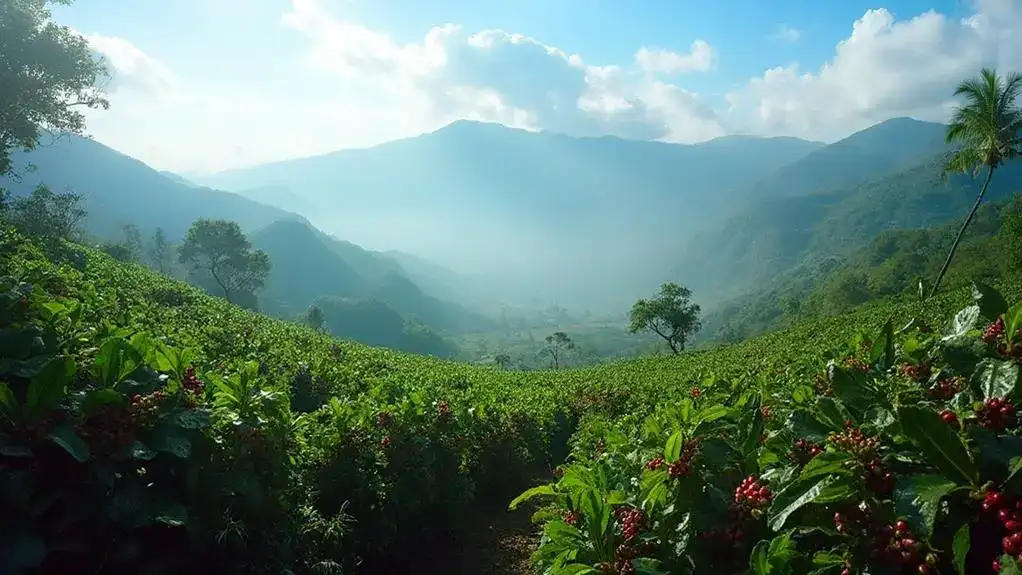
When it comes to coffee production in Mexico, several states stand out as major contributors to the country’s coffee yield.
These regions have a rich coffee history and are increasingly focusing on coffee sustainability to maintain their high-quality production.
Here are four key states:
- Chiapas: The largest coffee producer, known for its high-quality Arabica beans.
- Veracruz: Renowned as the birthplace of coffee in Mexico, offering diverse flavor profiles.
- Oaxaca: Famous for organic coffee, producing beans with complex flavors.
- San Luis Potosí: Gaining recognition for its sweet and fruity coffee, attributed to its unique climate.
These states showcase Mexico’s dedication to quality and sustainability in coffee cultivation, ensuring a bright future for their coffee industry.
What Are the Characteristics of Coffee from Different Mexico Regions?
When exploring coffee from different regions of Mexico, you’ll find a fascinating variety of flavor profiles that reflect each area’s unique growing conditions.
For instance, Chiapas beans often showcase bright acidity with chocolatey notes, while Oaxaca coffee tends to offer a rich, full body with sweet, fruity flavors.
Understanding these characteristics can help you appreciate the diverse coffee varieties cultivated throughout the country.
Flavor Profiles
Although each coffee-growing region in Mexico offers unique flavor profiles, they all share a common foundation rooted in the country’s diverse climate and rich soils. You’ll find a variety of tasting notes that reflect the distinct characteristics of each area.
| Region | Flavor Profile | Tasting Notes |
|---|---|---|
| Chiapas | Bright acidity | Chocolatey, fruity |
| Oaxaca | Rich body | Sweet, floral, chocolate |
| Veracruz | Smooth and balanced | Nutty, caramel, fruity |
| San Luis Potosí | Complex flavors | Nutty, chocolatey, bright acidity |
Exploring these flavor profiles helps you appreciate the depth and variety of Mexican coffee, whether you prefer a smooth cup or something bolder and more adventurous.
What Coffee Varieties Are Grown in Mexico?
In Mexico, you’ll primarily find Arabica coffee, known for its complex flavors and bright acidity, thriving in high-altitude regions like Chiapas and Veracruz.
While Robusta is less common, some areas are beginning to experiment with it, appreciating its stronger, bolder taste and higher caffeine content.
Understanding these varieties can enhance your appreciation of the unique characteristics that Mexican coffee offers.
Arabica vs. Robusta
Coffee enthusiasts often debate the merits of Arabica and Robusta beans, two main varieties grown in Mexico’s diverse regions.
- Arabica benefits: Smoother flavor, higher acidity, and aromatic qualities.
- Robusta challenges: Stronger, more bitter taste and lower acidity.
- Growing conditions: Arabica thrives at high altitudes, while Robusta prefers lower elevations.
- Usage: Arabica is popular in specialty coffee, Robusta often used in blends.
Popular Varieties in Mexico
Many coffee lovers mightn’t realize the incredible variety of flavors and profiles that emerge from Mexico’s diverse coffee-growing regions.
Each region offers popular coffee varieties, showcasing unique regional specialties:
- Chiapas: Bright acidity, chocolatey notes
- Oaxaca: Rich body, fruity flavors
- Veracruz: Smooth, caramel hints
- San Luis Potosí: Nutty, complex flavors
Exploring these varieties can enhance your appreciation for Mexican coffee culture.
How Does Climate Impact Mexico Coffee Quality?
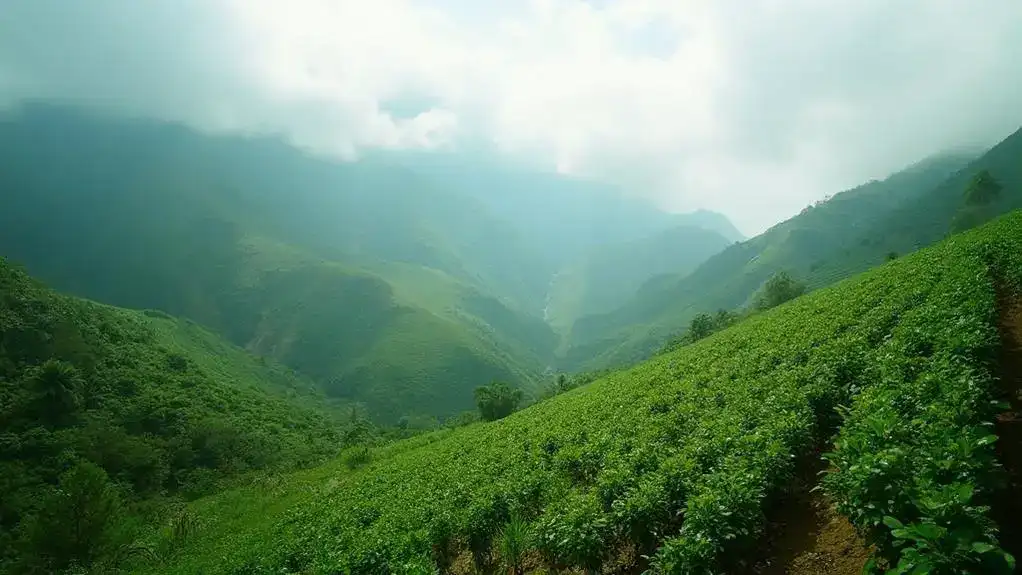
The climate in Mexico plays a vital role in determining the quality of coffee you enjoy.
High altitudes contribute to a slower maturation of coffee cherries, enhancing their flavor complexity and acidity.
Additionally, diverse microclimates across regions create unique growing conditions, allowing for a variety of taste profiles that can surprise even seasoned coffee drinkers.
Altitude Effects
Altitude plays an essential role in determining the quality of coffee grown in Mexico. The altitude impact considerably influences the flavor profile and overall quality of the beans.
Higher altitudes create cooler temperatures, which slow down the maturation of coffee cherries, allowing for more complex flavors to develop.
Here are some highland benefits:
- Enhanced acidity, giving coffee a bright and vibrant taste.
- Richer flavor profiles, often featuring fruity and floral notes.
- Ideal growing conditions, minimizing pests and diseases.
- Longer maturation periods, leading to more developed sugars.
Microclimates in Coffee Regions
In Mexico’s coffee regions, microclimates play an essential role in shaping the quality and characteristics of the beans you enjoy. The unique climate conditions, such as temperature variations and humidity levels, greatly impact the flavor profiles of the coffee produced.
This diversity fosters a rich tapestry of regional coffee diversity, enhancing the overall coffee experience.
- High altitudes lead to brighter acidity and complex flavors.
- Varied rainfall patterns contribute to the sweetness of the beans.
- Soil types influence the aromatic profiles and body.
- Temperature fluctuations create unique growing conditions.
What Is the Cultural and Economic Significance of Mexico Coffee?
Coffee holds significant cultural and economic value in Mexico, playing an essential role in local economies by providing livelihoods for thousands of farmers and workers.
You’ll find that coffee is deeply woven into various cultural traditions, from local festivals celebrating the harvest to everyday rituals surrounding its consumption.
Understanding these aspects helps highlight coffee’s importance not just as a beverage, but as a fundamental component of Mexican identity and economy.
Role in Local Economies
Coffee plays an essential role in the local economies of Mexico, providing employment opportunities and fostering community collaboration through coffee cooperatives.
These cooperatives not only support farmers but also help maintain quality and sustainability in coffee production.
Here are some key aspects of its importance:
- Job Creation: Coffee cultivation offers numerous jobs in rural areas, from farming to processing.
- Cooperative Benefits: Farmers band together to share resources and improve market access.
- Cultural Heritage: Coffee farming is deeply rooted in local traditions and practices.
- Economic Growth: The coffee industry contributes considerably to local and national economies.
Employment Opportunities
Cultivating coffee in Mexico not only enriches the cultural fabric of local communities but also serves as an essential economic engine.
Employment opportunities arise through:
- Coffee education programs
- Workforce development initiatives
- Sustainable farming practices
- Local cooperatives
These elements empower communities, boost local economies, and foster a deeper appreciation for coffee, ensuring that both the industry and its workers thrive.
Coffee Cooperatives
Across Mexico, numerous coffee cooperatives play an essential role in shaping local economies and preserving cultural heritage.
These cooperatives foster community support by:
- Providing fair wages to farmers
- Promoting sustainable farming practices
- Enhancing local infrastructure
- Encouraging cultural exchange and education
What Cultural Traditions and Practices Are Associated with Coffee?
When you explore coffee’s cultural significance in Mexico, you’ll notice its deep roots in indigenous communities.
These groups have cultivated coffee for generations, intertwining it with their traditions and livelihoods.
Understanding their practices not only highlights the importance of coffee in daily life but also showcases its role in preserving cultural heritage.
Indigenous Communities and Coffee
Coffee holds deep cultural and economic significance for many indigenous communities in Mexico, intertwining with their traditions and daily lives.
These communities embrace indigenous practices that enhance their cultural heritage through coffee cultivation.
Here are some key aspects of their relationship with coffee:
- Traditional farming methods
- Community gatherings centered around coffee
- Cultural rituals involving coffee
- Economic support from coffee sales
What Are Sustainable Mexico Coffee Farming Practices?
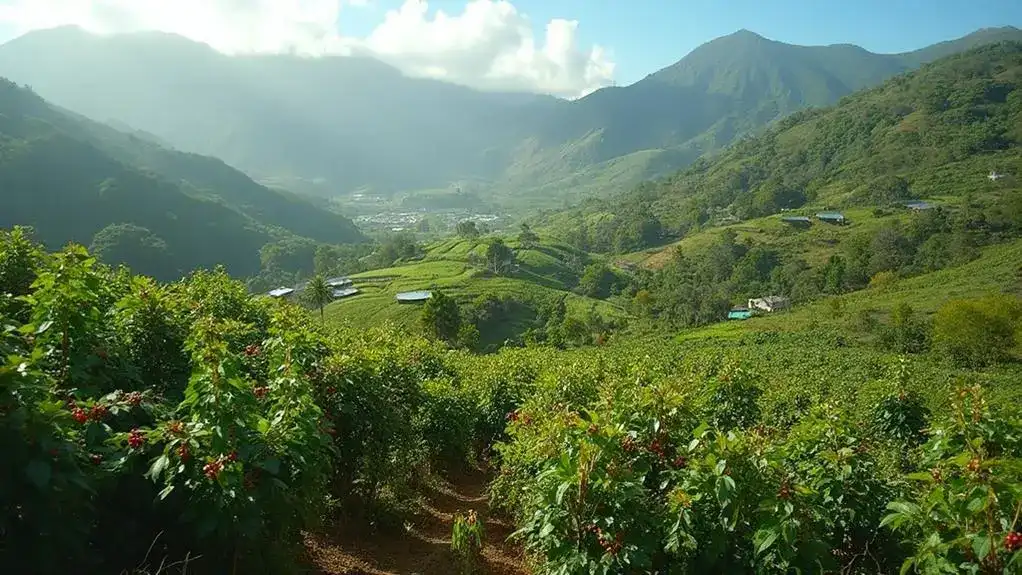
When you think about sustainable coffee farming in Mexico, organic coffee production stands out as a key practice.
This method emphasizes the use of natural fertilizers and pest control, avoiding synthetic chemicals that can harm the environment.
Organic Coffee Production
When you explore organic coffee production in Mexico, you’ll uncover the many benefits of sustainable farming practices.
These methods not only enhance the quality of the coffee but also contribute positively to the environment and local communities.
Here are some key advantages of sustainable practices:
- Promotes biodiversity by maintaining healthy ecosystems
- Reduces reliance on chemical fertilizers and pesticides
- Improves soil health and water conservation
- Supports fair trade and local farmers’ livelihoods
Benefits of Sustainable Practices
In Mexico, sustainable practices like organic coffee production offer significant benefits for both the environment and coffee quality.
By focusing on sustainable farming, you help preserve coffee biodiversity and promote healthier ecosystems.
Here are some advantages:
- Reduces chemical use
- Enhances soil health
- Supports local farmers
- Improves coffee flavor
These practices not only benefit your cup of coffee but also contribute to a sustainable future.
What Are the Coffee Production Statistics in Mexico?
Mexico ranks among the top coffee producers globally, primarily thanks to its diverse growing regions.
You’ll find that Chiapas leads the charge, contributing around 40% of the country’s total coffee production, followed closely by Veracruz and Puebla.
Understanding these key producing areas can give you a clearer picture of Mexico’s coffee industry and its impact on the global market.
Global Ranking and Production Volume
The country’s coffee production plays a vital role in the global market, ranking as the 10th largest coffee producer worldwide. In recent years, Mexico has contributed markedly to the global coffee supply, with production volumes reflecting the country’s rich agricultural heritage and diverse growing regions. Understanding these statistics helps you appreciate the trade dynamics at play in the global coffee market.
| Year | Production Volume (in metric tons) | Global Ranking | Key Factors |
|---|---|---|---|
| 2020 | 3,000 | 10th | High-quality Arabica beans |
| 2021 | 3,200 | 10th | Ideal climate and biodiversity |
| 2022 | 3,500 | 10th | Emphasis on sustainable practices |
| 2023 | 3,300 | 10th | Growth in organic coffee farming |
Key Producing Regions
Located in diverse landscapes across the country, Mexico’s key coffee-producing regions each contribute unique flavors and qualities to the coffee market.
These regions not only showcase Mexico’s rich coffee heritage but also employ various cultivation techniques, enhancing the quality of their beans.
Here are four notable coffee-producing regions:
- Chiapas: The largest producer, known for high-quality Arabica beans.
- Oaxaca: Famous for organic farming, yielding sweet and complex flavors.
- Veracruz: Offers smooth coffee with nutty undertones, benefiting from diverse microclimates.
- San Luis Potosí: Gaining recognition for its bright acidity and fruity profiles.
Understanding these regions helps you appreciate the depth and diversity of Mexican coffee, making every cup a unique experience.
What Challenges Are Facing coffee farmers in Mexico?
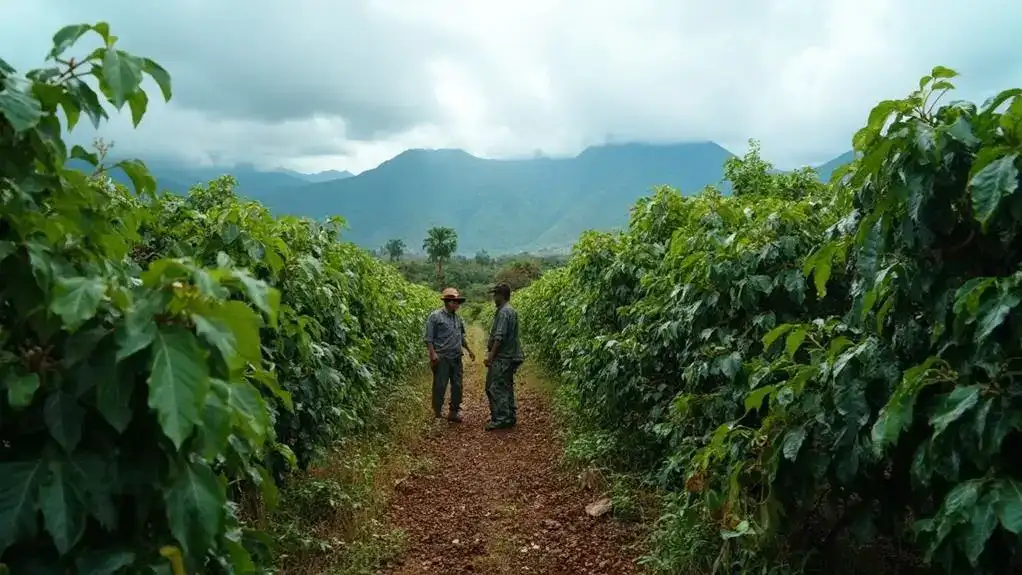
Coffee farmers in Mexico face significant challenges that threaten their livelihoods.
Climate change impacts, such as unpredictable weather patterns, can reduce crop yields, while market fluctuations often leave farmers struggling to secure fair prices for their beans.
Additionally, pests and diseases can devastate coffee plants, making it essential for farmers to adapt and find sustainable solutions.
Climate Change Impacts
As climate change continues to reshape weather patterns, coffee farmers in Mexico face increasing challenges that threaten their livelihoods and the quality of their crops.
Rising temperatures, unpredictable rainfall, and extreme weather events make it difficult for farmers to maintain consistent production. To combat these issues, many are adopting climate resilience strategies and exploring sustainable innovations.
Key challenges include:
- Increased pests and diseases affecting crop health.
- Water scarcity impacting irrigation practices.
- Altered growing seasons leading to reduced yields.
- Difficulty in maintaining coffee quality due to fluctuating climates.
Market Fluctuations and Pests
Facing market fluctuations and increasing pest pressures, coffee farmers in Mexico are grappling with significant challenges that threaten their livelihoods.
These farmers must adapt to changing market trends while implementing effective pest management strategies to sustain their crops.
Some key challenges include:
- Price volatility: Fluctuations in global coffee prices impact farmers’ income and planning.
- Pest infestations: Insects like the coffee borer beetle can devastate crops, leading to lower yields.
- Limited resources: Many farmers lack access to advanced pest management techniques and tools.
- Climate change: Shifts in weather patterns can exacerbate pest problems and affect crop quality.
How Is Coffee Harvested and Processed in Mexico?
In Mexico, coffee harvesting typically occurs between October and March, depending on the region’s climate and altitude.
Farmers use various processing methods, such as washed and natural, to enhance the flavor profiles of their beans.
Understanding these practices can give you a deeper appreciation for the coffee you enjoy.
Harvesting Seasons
During the coffee harvesting season in Mexico, which typically runs from November to March, farmers carefully hand-pick the ripe cherries to guarantee the finest quality. This method, known for its precision, allows for the selection of only the best cherries and highlights the importance of harvesting techniques.
Seasonal variations in climate and altitude also influence the timing and quality of the harvest across different regions.
Key aspects of the harvesting process include:
- Hand-picking: Guarantees only ripe cherries are selected.
- Timing: Harvesting occurs at peak ripeness for maximum flavor.
- Quality control: Farmers inspect cherries for defects.
- Local traditions: Many regions have unique harvesting customs.
These practices contribute to Mexico’s reputation for high-quality coffee.
Processing Methods
Coffee processing in Mexico involves several key steps that transform freshly harvested cherries into the flavorful beans you enjoy.
After harvesting, the cherries undergo processing techniques like wet or dry methods. The wet method includes coffee fermentation, where cherries are submerged in water, promoting the breakdown of the mucilage.
In contrast, the dry method involves spreading the cherries in the sun to dry naturally.
Here’s a quick overview of the main processing steps:
- Harvesting: Picking ripe cherries by hand.
- Pulping: Removing the outer skin.
- Fermentation: Breaking down mucilage for flavor enhancement.
- Drying: Reducing moisture content for storage.
These methods greatly influence the final taste and quality of the coffee you brew.
What Coffee Tourism and Experiences Are Available in Mexico?
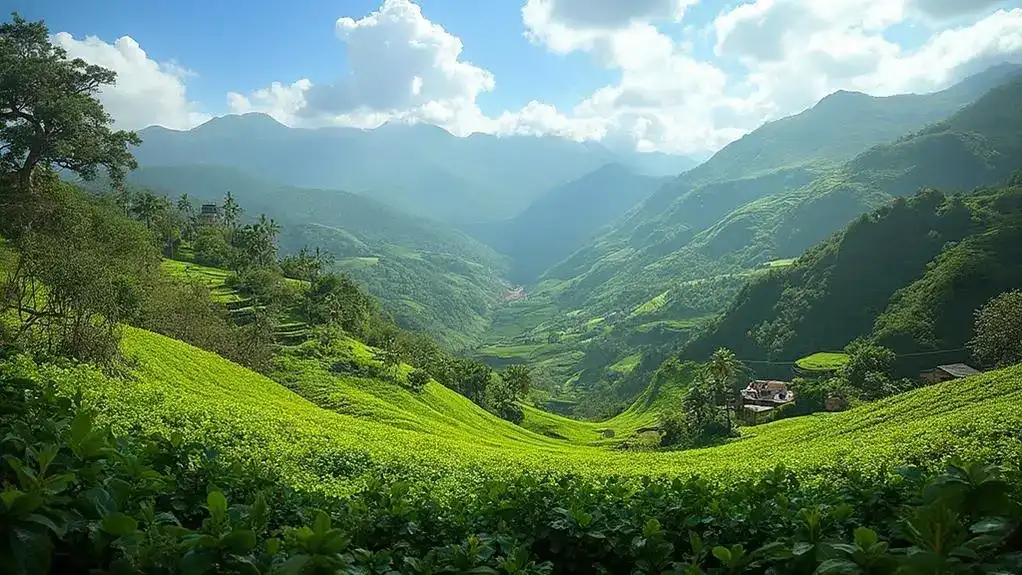
If you’re looking to explore coffee tourism in Mexico, Chiapas and Oaxaca offer some of the best experiences.
You can join guided tours through lush coffee plantations, where you’ll learn about the cultivation process and the unique traits of each region’s beans.
Additionally, tasting sessions often accompany these tours, allowing you to savor the rich flavors while immersing yourself in local coffee culture.
Coffee Tours in Chiapas and Oaxaca
While exploring the lush landscapes of Chiapas and Oaxaca, you’ll discover a vibrant coffee culture that invites you to immerse yourself in the world of coffee production.
Both regions offer unique Chiapas tours and Oaxaca experiences that highlight their rich coffee heritage. Here are some activities to enhance your visit:
- Farm Tours: visit local coffee farms to learn about sustainable farming practices and the coffee-making process.
- Workshops: Participate in hands-on workshops that teach you how to brew the perfect cup of coffee.
- Tastings: Enjoy guided tastings that showcase the distinct flavors of Chiapas and Oaxacan coffee.
- Cultural Exchanges: Engage with local farmers and artisans to understand their traditions and the significance of coffee in their lives.
These experiences provide a deeper appreciation for Mexico’s coffee culture.
Tasting and Cultural Experiences
Exploring Mexico’s coffee regions offers a rich tapestry of tasting and cultural experiences that engage all your senses.
You can immerse yourself in the local coffee culture while discovering the cultural significance behind each cup. Here are some ways to enhance your journey:
- Participate in cupping sessions to explore the unique tasting experiences of different regions.
- Visit local farms and learn about traditional coffee cultivation methods.
- Enjoy guided tours that take you through scenic coffee plantations.
- Attend festivals celebrating coffee and its role in Mexican heritage.
These experiences not only deepen your appreciation for coffee but also connect you to the rich history and customs that shape Mexico’s vibrant coffee culture.
What Is the Future of Coffee in Mexico?
As you look to the future of coffee in Mexico, you’ll notice several key trends shaping its production.
With climate change posing challenges, many regions are adopting innovative practices to guarantee sustainability and quality.
Additionally, the growing global demand for Mexican coffee presents exciting opportunities for producers to expand their reach and enhance their offerings.
Trends in Coffee Production
What does the future hold for coffee production in Mexico? As the industry evolves, you’ll notice exciting trends shaping the landscape.
Sustainable initiatives are gaining traction, promoting environmentally friendly practices that benefit both farmers and consumers. Coffee innovations, such as new processing methods and varietals, are enhancing flavor profiles and quality.
Here are some key trends to watch:
- Increased focus on organic and sustainable farming practices
- Development of specialty coffee markets with unique flavor profiles
- Adoption of technology for better crop management and yield
- Collaboration between farmers and roasters to elevate quality
These trends suggest a bright future for Mexican coffee, as the country continues to adapt and thrive in the global market.
How Is Mexico Adapting to Climate Change?
Climate change poses significant challenges for coffee production in Mexico, but the industry is adapting through innovative strategies.
Farmers are embracing sustainable innovations to enhance climate resilience, ensuring that coffee cultivation remains viable.
Here’s how they’re adapting:
- Diversifying crops to reduce dependence on coffee and improve soil health.
- Implementing agroforestry practices that combine coffee with trees, providing shade and reducing temperature fluctuations.
- Investing in water conservation techniques to manage resources better in drier conditions.
- Utilizing climate data to make informed decisions about planting and harvesting schedules.
What Is the Growing Global Demand for Mexican Coffee?
The rising global demand for Mexican coffee reflects a growing appreciation for its unique flavors and sustainable practices. As consumers seek ethically sourced options, Mexican coffee’s emphasis on sustainable sourcing and various coffee certifications becomes increasingly appealing. This trend suggests a bright future for coffee cultivation in Mexico.
Consider these key factors driving demand:
- Flavor Diversity: Mexican coffee showcases a range of profiles, from fruity to chocolatey.
- Sustainability: Many farms prioritize eco-friendly practices, attracting environmentally conscious consumers.
- Certifications: Quality certifications, such as organic and fair trade, enhance marketability.
- Cultural Heritage: Mexican coffee carries a rich history, connecting consumers to its origins.
These elements position Mexican coffee favorably in the global market.
Conclusion
While you might think all coffee is the same, exploring Mexico’s diverse coffee-growing regions reveals a world of unique flavors and cultivation methods. From the highlands of Chiapas to the organic farms of Oaxaca, each area contributes distinct profiles that elevate your coffee experience. Understanding these regions not only enhances your appreciation for every cup but also highlights the cultural and economic significance of Mexican coffee. Embrace this journey, and you’ll taste the difference in every sip.

